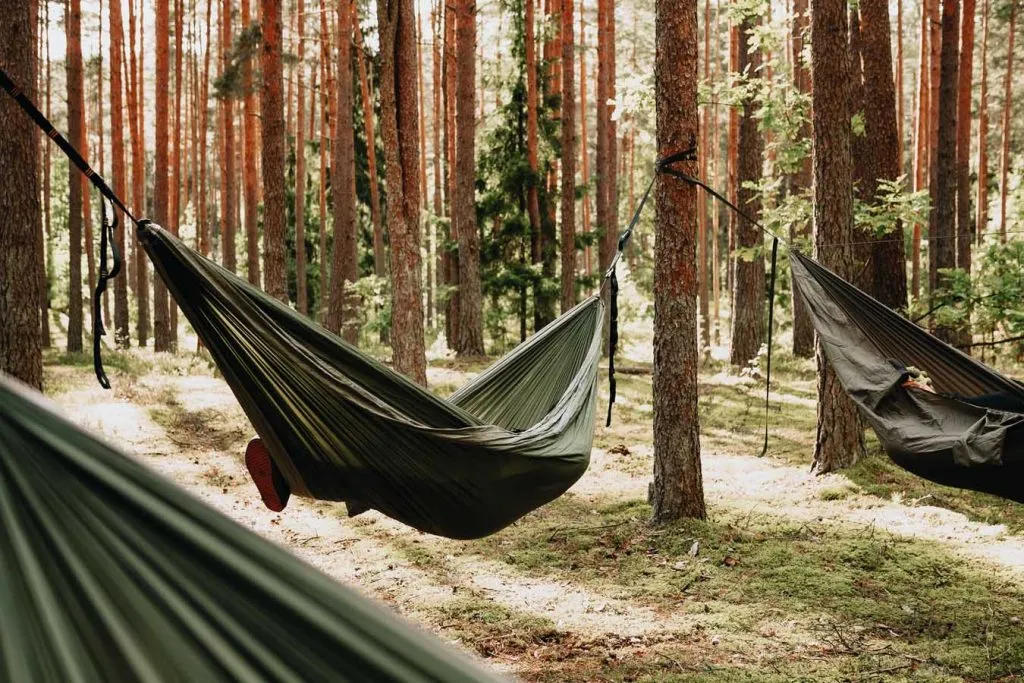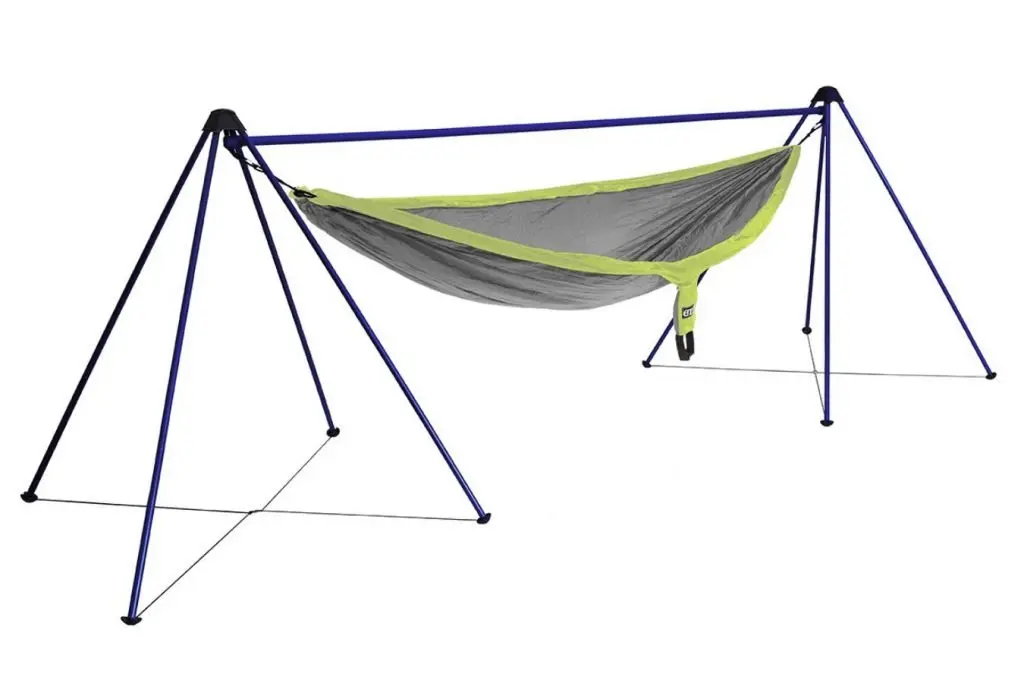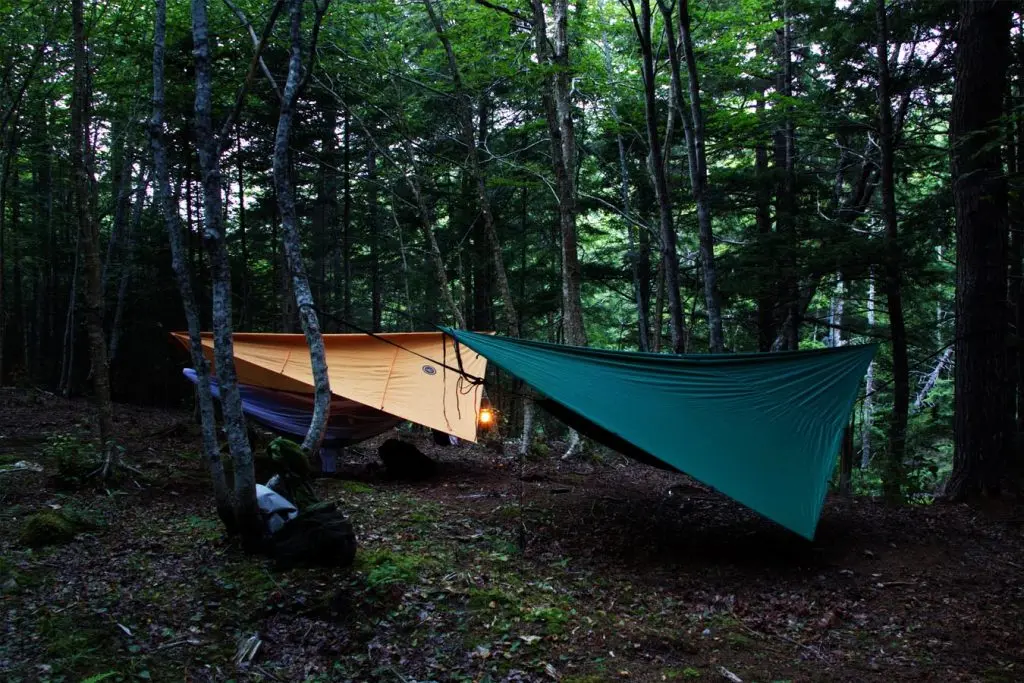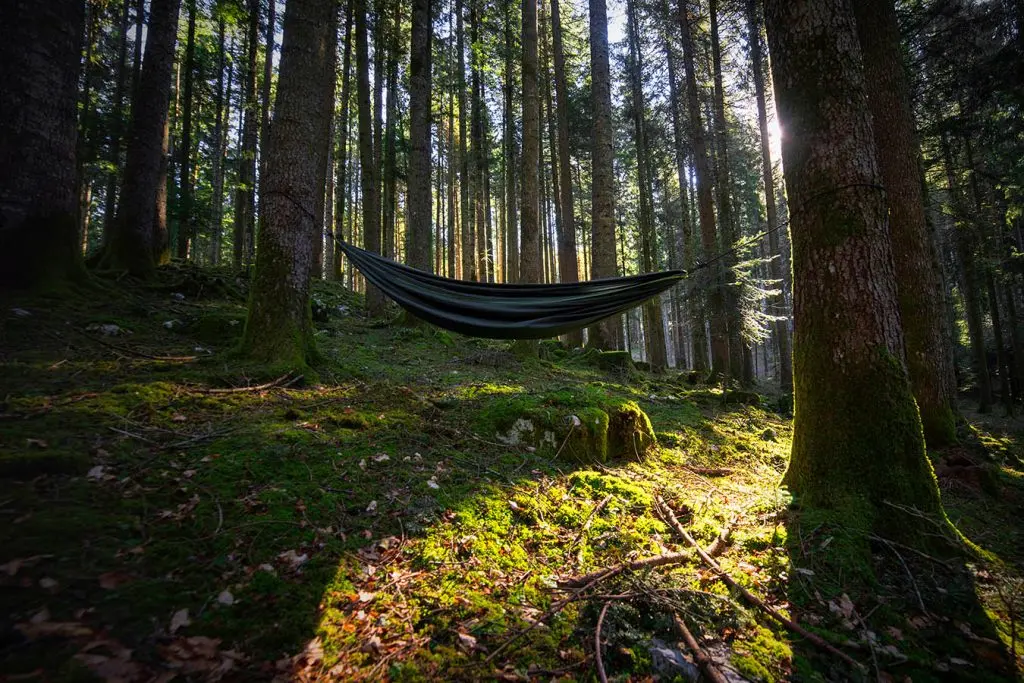Hammock hanging isn’t the hardest thing you will ever do, whether you are out camping or looking for the perfect spot in your backyard. However, things can get a little tricky when you have to pick the right trees to hang your hammock.
In this article, we will tell you how far apart the trees need to be, what you need to consider before picking the right trees, and what to look for in a tree. We will also tell you the perfect height to hang your hammock.
What’s the best hammock distance between two trees?
The best distance between two trees for a hammock is 15ft. However, some things could affect achieving this distance and setting your hammock in the perfect position.
Hammock hanging indoors is easy because you can set the distances pretty easily. But when you are camping in the woods and walking around looking for the perfect trees, you suddenly realize what a chore it can be.
Even if you are lucky to spot the right trees at the perfect distance, are you sure they can withstand your weight? Do you have a tarp that you wish to hang over your hammock that could affect the chosen trees? These and more factors need to be in your mind even as you look for the perfect distance between two trees.
Things to consider before picking your trees
Before you start looking for trees, there are a few things you need to keep in mind. These things will help you properly hang your hammock and preserve whatever trees you choose.
- Do you have a tarp? If so, figure out the ridgeline length and leave the appropriate space for it. We recommend you add about 4 feet to the ridgeline to have a good starting point. If you don’t have a tarp, then ignore this point.
- The type of suspension you plan to use. Some suspensions will require more space than others. For instance, if you plan to use whoopee slings with tree straps, you will need a bit more room. However, Atlas Straps or Slapstraps will need much less room. If you think finding the perfect trees will take time, you can plan early what type of straps to use.
- Look out for loose branches above. You don’t want widowmakers to come falling on you when strong winds blow. Find a different set of trees if the ones you picked have potentially harmful loose branches
- Does the spot have natural windbreakers? You will need the natural windbreakers unless you have underquilts and overquilts to keep the cold away at night. Set up your hammock next to bushes and shrubbery to keep the cold wind away at night.
- Tree strength. You have to find strong trees. Otherwise, they will lean toward your hammock and ruin the fun. If you pick trees that can’t withstand your weight, you risk breaking them. Dead trees are a no. Also, find trees with the right diameter – we will talk more about this in a different section.
Remember that you can only use hammock straps when camping, where it’s only for a short time. If you plan to permanently hang your hammock in your backyard, you need to use tree hooks. Tree hooks will keep the trees healthy, whereas straps can hinder growth or even kill the trees.
How far apart can trees be for a hammock?
You can address this question by measuring the length of your hammock from ring to ring. The hammock length is really what determines how far apart the trees can be. Once you have the length of your hammock, leave about 2 feet more than the hammock length.
However, there is also a matter of the tree straps. If you are going to use these, allow a bit more space for them – usually 3 to 4 feet. The extra room accommodates the straps and allows you to get the right sag.
Remember that sometimes the manufacturer may not specify the length of the hammock, in which case you will have to do the measuring yourself. Lay the hammock flat on the ground and measure it from ring to ring. Many hammocks measure about 11 feet in length. Here’s a table to explain this;

Another thing that may affect the distance between trees is whether you will use a tarp or not. Tarps are great for keeping away light rain and ensuring it doesn’t get too cold at night within the hammock.
If you have a tarp, the distance between trees will be longer than we just stated above. Some people use ridgelines to hang their tarps. Measure the length of your ridgeline and allow more space to accommodate it. That should make the distance between trees 2 or 3 more feet long.
A point to note: If you are going to use spreader bar hammocks which often don’t require more sag, you don’t need the extra 2 to 4 feet. The spreader bar hammocks are meant to be taut. Few campers use spreader bar hammocks, and you probably won’t need them in your backyard.
However, if you like to have a better view of your surroundings or sleep on your side, you can hang a spreader bar hammock. Measure the spreader bar hammock from ring to ring and determine how much suspension you will need.
Hammock Hang Calculator
The hammock hang calculator is a companion app that may be useful when trying to figure out the numbers before you hang your hammock in your backyard or camping area. The app allows you to key in certain numbers and figure out what you need for a particular point.
For instance, you can key in the height of your hammock and let the calculator figure out for you how high the suspensions need to be. If you have a ridgeline and know its length, the calculator can identify how far apart the trees need to be.
It’s not just the figures that the calculator can show you. You can also learn the physics of a hang. You can figure out how much tension and force need to be applied to the anchor points, the suspension lines, or the hammock. You can play around with values to figure out the perfect hang for your hammock.
How to select the right trees
It’s probably easier said than done, but finding the right tree to hang your hammock isn’t anyone’s cup of tea. Even veteran campers struggle to find the perfect trees to hang their hammocks. However, the process should be slightly more manageable with the following tips. You’ll still need to get to the camping spot to apply these tips, but it’s important to know them beforehand.
- Size
The aim is to find the strongest tree possible. Find out if the tree is healthy, strong, and stable. It should also be large enough to hold your weight without damaging the tree or risking injury to yourself. The rule of thumb is to find one you can’t easily shake.
Otherwise, it will not hold your weight as you lie on your hammock. If you can move the tree, don’t hang from it. It’s probably too small and will easily break when you sit on your hammock.
Ensure the tree is mature enough to handle your weight and anything else that will be part of your hammock. You are probably saying, “easy peasy!” That may be so, but you need to be careful when searching for a tree to hang your hammock. Don’t get excited until you have found the perfect tree size.
- Diameter
It’s not just a strong, healthy, stable, and mature tree that is good enough; you need to find one with the right diameter. You might find the right size tree that may not have the right diameter. For instance, you might find an oak tree that is huge and strong but too wide to be useful for hanging your hammock.
If the tree diameter is too wide, you will struggle with your hammock straps. You need to find one that will easily accommodate your strap length. The ideal diameter should be around 12 inches.
You need to realize that a tree with a large diameter will eat up your straps and leave you with very little room to work with. However, if you can find a tree with about 12-inch diameter, you will only need about 3 feet of straps to wrap around the trunk.
- Poisonous plants
Look out for Poison Ivy, poison, and other poisonous plants growing around the trees. Unless you want to have a rough time camping, pay attention to the plants around you. Some people say they are not allergic to these plants. However, even if that is the case, you want to ensure those around you enjoy their time as well.
Sometimes it makes a huge difference to know poisonous plants that may cause harm to you or your companions. Some plants look very similar and may be hard to distinguish. For instance, Poisonous Ivy looks very similar to Virginia Creeper, which is harmless. Watch out for climbers around the trees you plan to use to hang your hammock.
If the poisonous plant is around the tree you like, we recommend finding another tree. Don’t risk it. Also, pay attention to poisonous plants that grow out of the ground – these will also be harmful. If you are unsure about a plant, move on, it’s better to be safe than sorry.
- Loose Branches
Loose branches falling off your chosen tree will ruin your camping. We advise you set up your hammock while you still have daylight. Use the daylight to look up the trees and spot the loose branches that may fall off and cause injury or worse.
They are called Widowmakers for a reason – you don’t want to be on the wrong end of these branches. Spend some time surveying the entire tree and not just the trunk. Look out for dead branches without leaves.
What are the chances that a dead or loose branch may fall on you and injure you or, worse, kill you? Well, the chance is pretty high. Even when the dead branch looks harmless, do not take the chance. Wind storms at night are common and may dislodge the dead branch that will fall on you.

- Tree Strength
This tip is not just for campers but those who plan to hang their hammocks in the backyard. You want to hang your hammock from a tree that is the perfect size and shape. One that will support the weight you plan to put on it without breaking or causing injury to you or your family.
Ensure the tree can withstand the weather elements that may threaten its existence. There are plenty of such trees that also have the right diameter to accommodate your straps.
- Bark
The tree’s bark will tell you whether it’s healthy or not. If you notice that the bark is damaged, try and find out why. There are probably pests inside it that are eating away the wood. The tree may be slowly dying and its integrity compromised. Also, find out if there are large portions of the bark that may be missing. There is a chance that the weather elements have damaged it and it’s dying.
If you find a lot of mold and fungus, it may be a sign that the tree is dying. Mold and fungus eat away the tree’s living tissue and cause the wood to rot. Check other trees around to ensure they are not infected by mold and fungus.
- Type of tree
Since finding the perfect trees can sometimes be a nightmare when you are out camping, it’s not forbidden to find one that meets the criteria and go with it. However, some trees are known for their resilience and lastingness. You want to find these trees and use them to hang your hammock.
Some examples include the oak and maple trees. These may not be common in your area, but you can find out what type of trees grow in your town beforehand. Oak trees are stable, but some may be too wide. Try and find extra long straps if oaks are prevalent in your area. Maple trees are fantastic for hanging a hammock. They are also resilient and stable.
- Angle
What about trees on a hill? Aren’t they too risky? Not at all. As long as you hang your hammock at the right height, trees on the angled ground will do the job just fine. Your hammock will still be level even though the ground beneath isn’t.
However, ensure it’s safe to step in and out of your hammock. Also, if you don’t have a problem with the angled ground, other people in your company may not be so confident – especially kids. You are safer on flat ground if the young ones are out camping with you.
What if the hanging distance is too far apart?
You will enjoy your hammock if you have enough space to sway freely without getting tangled in branches or ropes. These may damage your hammock and ruin your fun.
If the trees are too far apart, use longer straps that will ensure you get more sag. Also, you could use a ridgeline when the distance is over 20 feet. If you can’t find the perfect trees, use a single tree and find something else for the second anchor point.

How big should a tree be to support a hammock?
If you find a strong enough tree, it’s perfect for hanging your hammock. Try and shake the tree to measure its strength. Some tree species are bigger and stronger than others. What matters is whether the tree can support the weight you plan to impose on it. If you can find one 6-12 inches thick, you are good to go.
What is the best height to hang a hammock?
The height of your hammock will depend on a few things. First, you need to find out how far up you’d like to be. Ensure you can comfortably get in and out of your hammock. Also, you want to make sure you get the right sag depending on the trees you choose.
If the trees are too far apart, the sag may be perfect, but sometimes the hammock may be too close to the ground. The ideal height should be about 18 inches from the ground or 2 to 5 feet from the ground.
Summary
So what is the best hammock distance between trees? You will need to figure this out yourself as you walk around the woods or in your backyard looking for the perfect trees. The ideal distance between trees should be about 15 feet. This is determined by the length of your hammock from ring to ring.
If you are using spreader bar hammocks, you don’t need plenty of space because they need to remain taut. When looking for trees, find out what type of gear you plan to use and the condition of the trees. Look out for the ground underneath and for the health and safety of those around you.
The perfect hammock height is 2 to 5 feet from the ground.




